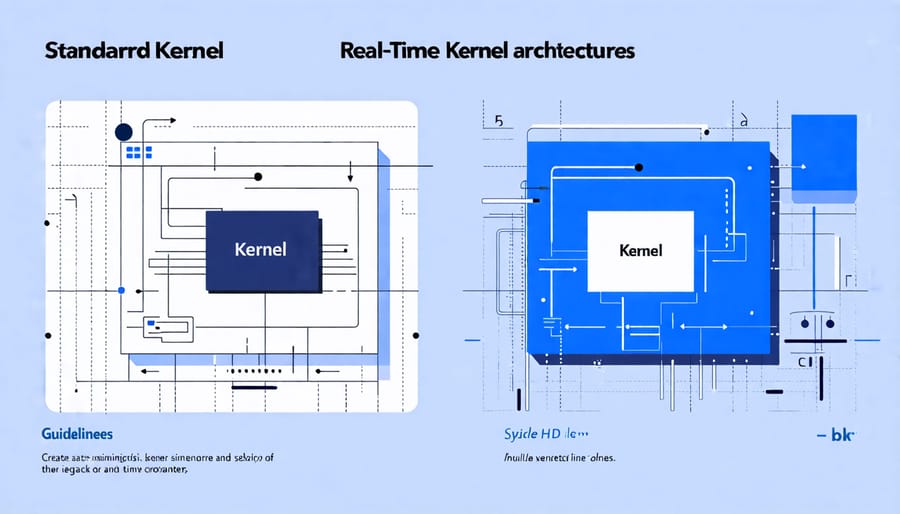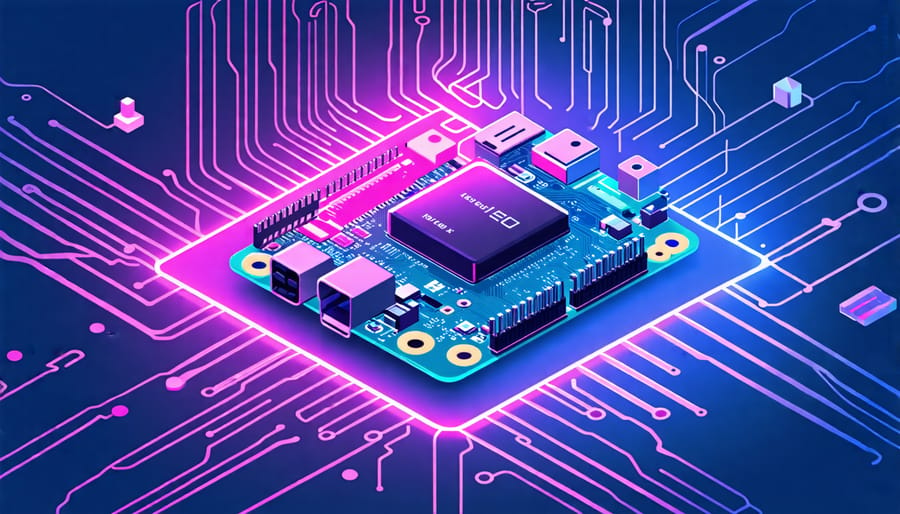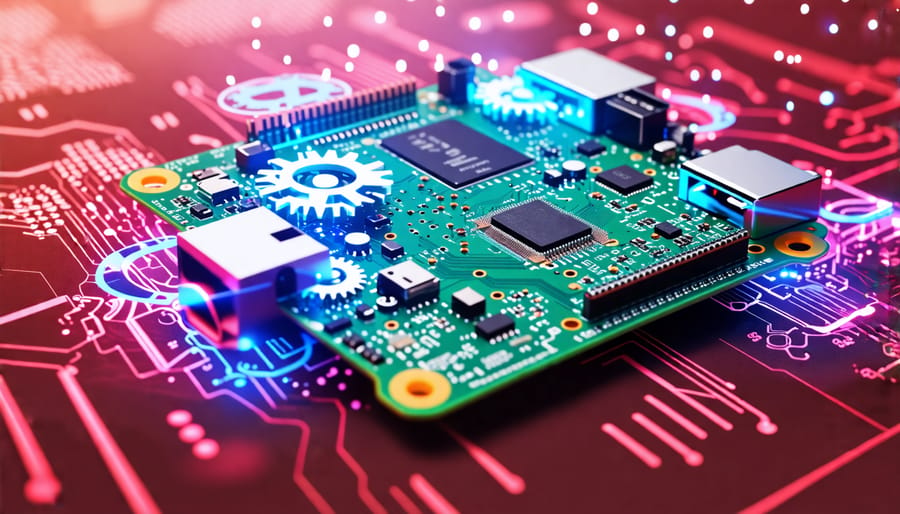Unlock the power of real-time performance on your Raspberry Pi with a real-time kernel. Designed to prioritize time-critical tasks and minimize latency, a real-time kernel transforms your Raspberry Pi into a robust platform for applications demanding precise timing and deterministic behavior. From industrial automation and robotics to audio processing and embedded systems, a real-time kernel empowers your Raspberry Pi to tackle demanding projects with unparalleled responsiveness and reliability. Embrace the cutting-edge capabilities of real-time computing and take your Raspberry Pi projects to new heights of performance and innovation.
What is a Real-Time Kernel?

Deterministic Timing
A real-time kernel ensures that tasks are executed within strict, predefined time constraints, providing deterministic timing. This is crucial for applications that require precise control and responsiveness, such as robotics, industrial automation, and multimedia processing. Unlike a general-purpose operating system, a real-time operating system (RTOS) prioritizes tasks based on their deadlines and criticality, guaranteeing that high-priority tasks are completed within their allocated time slots. The real-time kernel achieves this by employing scheduling algorithms that minimize latency and maximize predictability. By eliminating sources of unpredictability, such as resource contention and interrupts, the real-time kernel provides a stable and reliable platform for time-sensitive applications. This deterministic behavior is essential for ensuring the smooth operation of real-time systems, where missed deadlines can lead to system failures or even safety hazards. With a real-time kernel, Raspberry Pi users can harness the power of deterministic timing for their projects, opening up new possibilities in fields like robotics, control systems, and embedded devices.
Priority-Based Scheduling
A real-time kernel for Raspberry Pi employs priority-based scheduling to ensure critical tasks are handled promptly. When multiple tasks compete for system resources, the kernel assigns higher priority to time-sensitive operations, such as controlling sensors or responding to real-time events. Less urgent tasks, like background processes or user interface updates, receive lower priority. This scheduling mechanism guarantees that essential tasks experience minimal latency and deterministic execution times, preventing delays that could compromise system performance or responsiveness. By prioritizing tasks based on their importance and time constraints, a real-time kernel optimizes resource allocation and maintains the stability and reliability of real-time applications running on Raspberry Pi.
5 Benefits of Using a Real-Time Kernel on Raspberry Pi
Enhanced Responsiveness
The Raspberry Pi’s real-time kernel significantly enhances system responsiveness, making it ideal for time-sensitive applications. By prioritizing critical tasks and minimizing latency, the real-time kernel ensures that high-priority processes are executed promptly and consistently. This enhanced responsiveness is particularly beneficial for projects involving real-time data acquisition, control systems, robotics, and multimedia applications.
With a real-time kernel, the Raspberry Pi can respond to external events and interrupts with minimal delay, guaranteeing deterministic behavior and predictable execution times. This level of responsiveness is essential for applications that require precise timing, such as controlling motors, reading sensors, or generating audio and video outputs. By eliminating the unpredictability associated with standard kernels, the real-time kernel enables the Raspberry Pi to deliver reliable and consistent performance in demanding real-time scenarios.
Increased Reliability
A real-time kernel significantly enhances the reliability and stability of Raspberry Pi systems. By prioritizing critical tasks and ensuring they are executed within strict time constraints, the real-time kernel prevents system crashes caused by missed deadlines or resource contention. This predictable and deterministic behavior is crucial for applications that require high reliability, such as industrial control systems, robotics, and medical devices. The real-time kernel’s preemptive scheduling algorithms allow time-sensitive tasks to take precedence over less critical ones, guaranteeing that essential functions are always performed on time. Additionally, the kernel’s advanced memory management and resource allocation techniques minimize the risk of memory leaks and resource exhaustion, further contributing to system stability. With a real-time kernel, Raspberry Pi users can have confidence in the consistent and dependable operation of their projects, even under demanding real-time conditions.
Improved Resource Management
A real-time kernel optimizes resource management by prioritizing critical tasks and minimizing latency. It employs preemptive scheduling, allowing high-priority tasks to interrupt lower-priority ones, ensuring time-sensitive operations are completed within strict deadlines. The kernel also provides deterministic behavior, guaranteeing predictable execution times for real-time tasks. By efficiently allocating CPU time, memory, and other resources, a real-time kernel prevents resource contention and ensures smooth performance. Additionally, it offers low-latency interrupt handling, quickly responding to external events and minimizing delays. With fine-grained control over system resources and the ability to prioritize tasks based on their importance, a real-time kernel delivers optimal performance for time-critical applications on the Raspberry Pi.

Expanded Project Possibilities
With a real-time kernel, your Raspberry Pi can tackle projects that require precise timing and fast response times. Imagine building a high-speed data acquisition system that collects sensor data at exact intervals or a real-time audio processing unit that applies effects without any noticeable latency. You can even create your own industrial control systems, such as PID controllers, that maintain tight control loops for temperature, pressure, or motion regulation. Real-time kernels open up a world of possibilities for robotics projects, allowing you to achieve smooth, synchronized movements and rapid responses to sensor inputs. From autonomous vehicles to advanced manufacturing systems, a real-time kernel empowers your Raspberry Pi to handle time-critical tasks with unparalleled precision. Whether you’re an experienced engineer or a curious hobbyist, exploring the potential of real-time kernels can take your Raspberry Pi projects to new heights of performance and innovation.
Community Support and Resources
The Raspberry Pi community is known for its vibrant and supportive members who are always eager to help fellow enthusiasts with their projects. Whether you’re a beginner or an experienced user, you’ll find a wealth of resources available to guide you through the process of implementing a real-time kernel on your Raspberry Pi. From official documentation and tutorials to community forums and social media groups, there’s no shortage of knowledge and inspiration to draw from. The community is particularly active on platforms like the Raspberry Pi forums, Stack Exchange, and GitHub, where users share their experiences, troubleshoot issues, and collaborate on innovative projects. Many community members have already successfully implemented real-time kernels in their Raspberry Pi projects and are happy to share their insights and best practices. With such a supportive and knowledgeable community at your fingertips, you’ll never feel alone in your real-time Raspberry Pi journey.
Getting Started with a Real-Time Kernel on Raspberry Pi
To get started with a real-time kernel on your Raspberry Pi, you’ll need to download a compatible kernel image and flash it to your SD card. Several pre-built real-time kernel images are available, such as the popular RT-PREEMPT patch. Once you’ve flashed the image, boot your Raspberry Pi and verify that the real-time kernel is running by checking the system information.
Next, configure your system to take advantage of the real-time capabilities. This may involve setting up priority-based scheduling, tuning kernel parameters, and configuring your application to use real-time APIs. Tools like cyclictest can help you measure latency and ensure your system meets real-time requirements.
With a real-time kernel, your Raspberry Pi can tackle time-critical tasks in industrial automation, robotics, and edge computing applications. Experiment with different configurations and test your application under various loads to optimize performance. Remember to keep your kernel and firmware up to date for the best results. With a little effort, you’ll be well on your way to unlocking the real-time potential of your Raspberry Pi.

Conclusion
The real-time kernel for Raspberry Pi offers a powerful solution for projects that require deterministic performance and low latency. By ensuring consistent response times and minimizing delays, the real-time kernel enables Raspberry Pi to excel in applications such as robotics, audio processing, and industrial control systems. Whether you’re a hobbyist looking to push the boundaries of your projects or an educator seeking to introduce students to the world of real-time computing, the real-time kernel for Raspberry Pi provides a stable and reliable foundation. With its open-source nature and active community support, you’ll find ample resources and inspiration to help you get started and unleash the full potential of your Raspberry Pi. So why not explore the exciting possibilities of real-time computing and take your projects to the next level?


